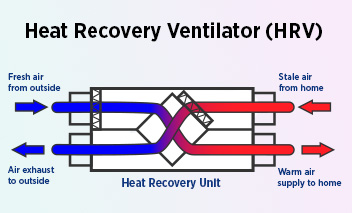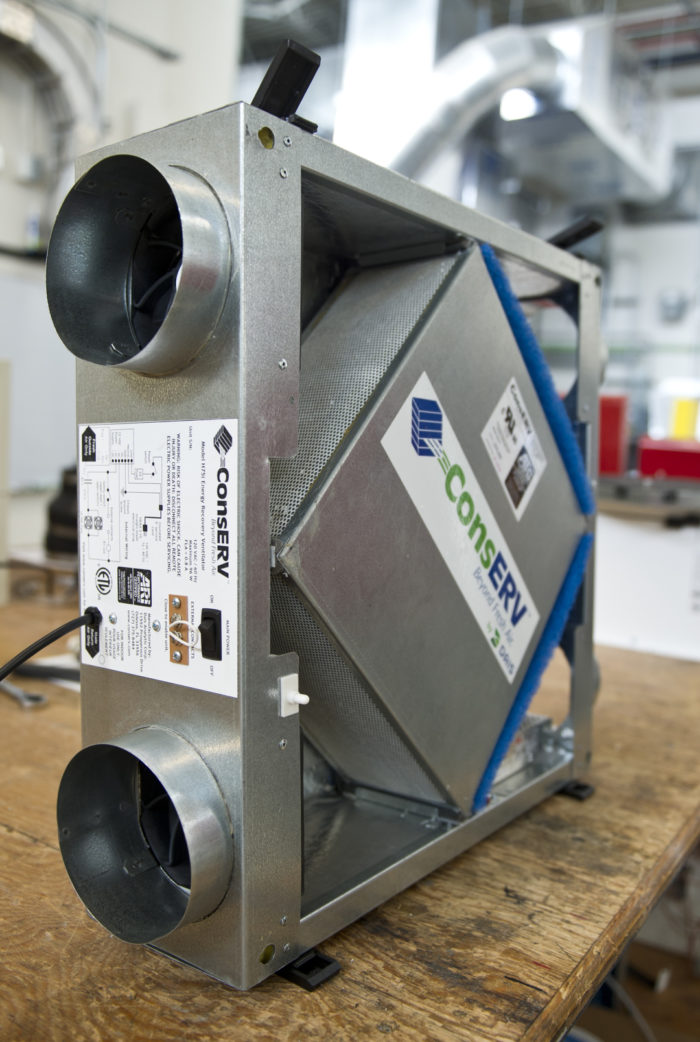The Top 5 Questions Homeowners Ask About HRV
Wiki Article
Introducing the Secret Advantages and Uses of Heat Recovery Ventilation in Sustainable Design
Heat Recovery Ventilation (HRV) systems play a vital role in sustainable design. They promote a continual exchange of stale indoor air with fresh outside air, greatly improving interior air quality. HRVs add to energy efficiency by redeeming warmth from worn down air, which can decrease energy costs. Comprehending the multifaceted benefits and applications of HRVs discloses their significance in modern architecture. What other benefits do these systems supply in the search of sustainability?Recognizing Heat Recovery Ventilation Equipments
Heat recovery ventilation (HRV) systems are made to improve indoor air quality while reducing energy loss. These systems utilize a mechanical ventilation technique to exchange stale indoor air with fresh outdoor air, guaranteeing a constant supply of tidy air. By recording warm from the exhaust air, HRVs prerequisite incoming air, reducing the demand on home heating and cooling systems. This process not only improves thermal convenience but also contributes to power effectiveness in residential and industrial structures. Additionally, HRV systems help control moisture degrees and reduce interior pollutants, promoting a healthier living atmosphere. Their tactical execution is important for attaining sustainable layout goals, as they provide a balance in between power preservation and owner health.Just How HRV Equipment Work
While several might be acquainted with air flow systems, comprehending just how heat healing air flow (HRV) systems run is vital for valuing their benefits. HRV systems function by exchanging stale indoor air with fresh outdoor air while moving heat between the two streams. This procedure occurs in a warmth exchanger, where warm from the outgoing air warms the inbound air during colder months, minimizing power loss. Conversely, in warmer months, the system can cool down incoming air utilizing the cooler outward bound air. HRVs are geared up with followers to assist in airflow and filters to eliminate particulates, ensuring a continuous, balanced ventilation process. This ingenious layout not only improves energy performance but likewise adds to keeping a comfortable interior setting.Enhancing Indoor Air High Quality
Indoor air high quality can greatly impact wellness and well-being, making reliable ventilation crucial in modern homes. Heat Recovery Ventilation (HRV) systems play a vital role in preserving interior air high quality by continually trading stagnant indoor air with fresh outside air. This process not just reduces air-borne contaminants yet additionally reduces moisture degrees, which can cause mold development and respiratory problems. HRV systems filter incoming air, removing irritants and particulates, thereby supplying a much healthier living environment. Additionally, these systems assist eliminate odors and unpredictable organic substances (VOCs) generally located in household products. By ensuring a consistent flow of tidy air, HRV systems add to a total enhanced interior atmosphere, promoting convenience and health for passengers.Energy Effectiveness and Expense Financial Savings
Energy performance sticks out as a considerable advantage of Heat Recovery Ventilation (HRV) systems. By capturing and recycling the warmth from worn down indoor air, HRVs decrease the energy required for heating incoming fresh air, leading to minimized energy intake. This efficiency translates right into reduced energy bills, using considerable price financial savings for home owners and organizations alike. In addition, HRV systems commonly receive energy performance rewards and rebates, better boosting their economic allure. Over time, the first financial investment in HRV innovation can lead to a positive return on financial investment through lowered power expenses. The combination of HRV systems not only promotes lasting design however likewise offers a practical solution for attaining long-lasting power cost savings and economic benefits.Environmental Benefits of HRV

A wide range of ecological benefits arises from the execution of Heat Recovery Ventilation (HRV) systems. By efficiently transferring warmth from exhaust air to inbound fresh air, HRVs substantially reduce the power needed for home heating and cooling down areas. This power effectiveness translates to lower greenhouse gas emissions, adding to a decrease in the general carbon footprint of structures. Additionally, HRV systems boost indoor air high quality by constantly distributing fresh air, thereby minimizing the focus of interior pollutants and irritants. The decrease in power usage help in preserving natural sources, making HRVs a vital element of lasting design. Generally, the ecological advantages of HRVs play an important duty in promoting a healthier planet and cultivating environment-friendly structure practices.
Versatile Applications in Modern Architecture
Heat recovery ventilation (HRV) systems are increasingly being integrated right into both household and business architectural projects. In domestic settings, HRVs improve interior air quality while optimizing power efficiency. In industrial areas, these systems maximize ventilation techniques, showing their convenience in contemporary architectural applications.Residential Projects Combination
While contemporary design increasingly emphasizes sustainability, the combination of heat healing air flow systems in household projects has arised as a practical option for enhancing interior air top quality and power efficiency. These systems you could check here effectively move warm from exhaust air to inbound fresh air, lessening energy loss and reducing home heating or cooling down needs. In new builds and retrofits alike, heat healing air flow can be seamlessly included, providing house owners with a healthier living setting while lowering utility costs. Furthermore, with boosting awareness of ecological effects, more engineers and home builders are identifying the lasting advantages of these systems. Therefore, heat recovery air flow has come to be a vital part of lasting residential design, showcasing flexibility and dedication to environment-friendly methods.Industrial Spaces Optimization
As modern commercial areas progress to fulfill the demands of sustainability and effectiveness, the execution of warmth recovery ventilation systems arises as a key method for maximizing indoor settings. These systems facilitate the exchange of stale interior air with fresh outdoor air while reclaiming warm energy, considerably minimizing energy usage. This not just enhances comfort for residents yet also assists in decreasing operational costs. Functional applications can be observed in offices, retail spaces, and educational establishments, where air high quality and temperature level control are extremely important. Additionally, integrating heat recuperation ventilation straightens with environment-friendly structure certifications, further promoting ecological responsibility. Ultimately, taking on such systems in commercial architecture not just adds to sustainability objectives however also cultivates healthier, much more productive rooms for customers.
Integrating HRV Into Sustainable Style Practices
Incorporating heat recovery air flow (HRV) systems right into lasting style techniques uses substantial benefits in energy performance and indoor air top quality. By utilizing HRV, designers can develop economical solutions that not only decrease power usage however also boost the overall comfort of indoor atmospheres. This alignment with sustainability objectives positions HRV as a necessary component in contemporary building methods.
Energy Efficiency Enhancement
By including warm recovery air flow (HRV) systems into lasting design practices, architects and contractors can significantly boost energy efficiency in modern constructions. HRV systems work by recording heat from outward bound stagnant air and transferring it to inbound fresh air, lessening the power needed for home heating or cooling indoor rooms. This procedure not only decreases reliance on typical a/c systems yet likewise lowers overall power consumption. On top of that, HRV systems can aid keep a regular indoor temperature, minimizing peak energy demands. By integrating these systems, structures can attain substantial reductions in utility prices and carbon impacts, lining up with sustainability goals. Ultimately, HRV innovation stands for a useful solution for boosting power performance in the built environment, advertising even more liable source use.Indoor Air Quality Improvement
Just how can heat healing ventilation (HRV) systems contribute to exceptional indoor air top quality in modern buildings? HRV systems successfully exchange stagnant interior air with fresh outdoor air while recuperating heat, minimizing temperature level fluctuations. This procedure decreases the concentration of interior toxins, such as volatile natural substances (VOCs), irritants, and moisture, which can degrade air quality and impact occupant wellness. By keeping excellent humidity levels and making certain a continuous supply of tidy air, HRVs assist develop a healthier interior environment. In enhancement, these systems can be incorporated right into lasting style methods, advertising power effectiveness alongside enhanced air top quality. HRV Heat Recovery Ventilation. Consequently, HRV innovation plays a crucial role beforehand general owner convenience and health in modern building layoutsEconomical Style Solutions

Often Asked Inquiries
What Maintenance Is Required for Heat Recovery Ventilation Solutions?

Upkeep for warm healing air flow systems usually includes regular filter replacements, cleansing of heat exchangers, assessment of followers and ducts, and making sure correct drain. These jobs help preserve performance and extend the system's lifespan over time.
Can HRV Systems Be Mounted in Existing Buildings?
Heat recovery ventilation systems can indeed be mounted in existing structures. HRV Heat Recovery Ventilation. Retrofitting requires mindful planning and evaluation of the structure's format, guaranteeing compatibility with current systems while making best use of power effectiveness and interior air qualityHow Do HRV Systems Influence Sound Degrees Inside?
HRV systems can influence indoor noise degrees by presenting audio from outside sources via air flow. Premium installments typically integrate sound-dampening features, decreasing noise effect while offering effective air exchange and keeping comfort indoors.Exist Any Drawbacks to Utilizing HRV Solutions?
The drawbacks of utilizing HRV systems consist of possible high initial costs, maintenance challenges, and the possibility of reduced interior air high quality if filters are sporadically transformed, which could cause problems with moisture levels.Exactly how Do I Pick the Right HRV System for My Needs?
Picking the right heat recovery air flow system includes evaluating particular needs, such as developing dimension, climate, look at these guys and energy efficiency objectives. Additionally, examining system functions, installment demands, and upkeep factors to consider is essential for peak efficiency and complete satisfaction.Report this wiki page